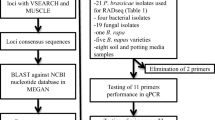Abstract
The relation between diversity of pathogenicity on clubroot-resistant (CR) cultivars of Chinese cabbage (Brassica rapa subsp. pekinensis) bred in Japan and DNA polymorphisms in 17 populations of Plasmodiophora brassicae from cruciferous plants was examined by inoculation tests and random amplified polymorphic DNA (RAPD) analysis using 18 arbitrary primers. Four pathotypes (A–D) were identified after inoculation of six CR cultivars of Chinese cabbage in the 17 populations from cruciferous crops. A relatively high level of genetic diversity was also detected among these populations in the RAPD analysis. Although the four pathotypes could not be clearly differentiated using the RAPD data, most populations of three pathotypes had a consistent location on the dendrogram. All pathotype B (virulent on five cultivars except Utage 70) and D (avirulent on all cultivars) populations, which were common in incompatible interactions with cv. Utage 70, were located in a single subcluster. All five pathotype C populations (virulent only on cv. Utage 70) except for one population grouped in another single subcluster. Because four pathotype A populations (virulent on all six cultivars, races 4 and 9) fell in different subclusters, the populations may be genetically polyphyletic. Populations from cruciferous weed Cardamine flexuosa differed remarkably from those from cruciferous crops in pathogenicity on common cultivars of Chinese cabbage and turnip and C. flexuosa, but they grouped in a single cluster with all race 9 populations from crops. Race 9 populations from crops may thus be closely related to populations from the weed rather than to races 1 and 4 from crops.



Similar content being viewed by others
References
Buczacki ST, Toxopeus H, Mattusch P, Johnston TD, Dixon GR, Hobolth LA (1975) Study of physiologic specialization in Plasmodiophora brassicae: proposals of attempted rationalization through an international approach. Trans Br Mycol Soc 65:293–303
Buhariwalla H, Greaves S, Magrath R, Mithen R (1995) Development of specific PCR primers for amplification of polymorphic DNA from the obligate root pathogen Plasmodiophora brassicae. Physiol Mol Plant Path 47:83–94
Colhoun J (1958) Clubroot disease of crucifers caused by Plasmodiophora brassicae Woronin. Phytopathol paper no. 3. Commonwealth Mycol Inst, Kew
Fähling M, Graf H, Siemens J (2003) Pathotype separation of Plasmodiophora brassicae by the host plant. J Phytopath 151:425–430
Halsted BD (1894) Club-root in common weeds. Bull Torrey Bot Club 21:76–78
Hatakeyama K, Fujimura M, Ishida M, Suzuki T (2004) New classification method for Plasmodiophora brassicae field isolates in Japan based on resistance of F1 cultivars of Chinese cabbage (Brassica rapa L.) to clubroot. Breed Sci 54:197–201
Ito S, Maehara T, Tanaka S, Kameya-Iwaki M, Yano S, Kishi F (1997) Cloning of a single-copy DNA sequence unique to Plasmodiophora brassicae. Physiol Mol Plant Pathol 50:289–300
Karling JS (ed) (1968) The Plasmodiophorales, 2nd edn. Hafner Publishing, New York
Kuginuki Y, Yoshikawa H, Hirai M (1999) Variation in virulence of Plasmodiophora brassicae in Japan tested with clubroot-resistant cultivars of Chinese cabbage (Brassica rapa L. ssp. pekinensis). Eur J Plant Pathol 105:327–332
Manzanares-Dauleux MJ, Divaret I, Baron F, Thomas G (2001) Assessment of biological and molecular variability between and within field isolates of Plasmodiophora brassicae. Plant Pathol 50:165–173
Möller M, Harling R (1996) Randomly amplified polymorphic DNA (RAPD) profiling of Plasmodiophora brassicae. Lett Applied Microbiol 22:70–75
Nei M (1987) Molecular evolutionary genetics. Columbia University Press, New York
Seaman WL, Walker JC, Larson RH (1963) A new race of Plasmodiophora brassicae affecting Badger Shipper cabbage. Phytopathology 53:1426–1429
Tanaka S, Negoro M, Ota T, Katumoto K, Nishi Y (1990) Clubroot of spring Chinese cabbage in Nagasaki prefecture, Kyushu. Bul Fac Agric Yamaguchi Univ 38:33–45 (in Japanese)
Tanaka S, Sakamoto Y, Kajima K, Fujieda K, Katumoto K, Nishi Y (1991) Pathogenicity of three isolates attacking clubroot-resistant cultivars of Chinese cabbage. Bull Fac Agric Yamaguchi Univ 39:113–122
Tanaka S, Ito S, Kameya-Iwaki M, Katumoto K, Nishi Y (1993) Occurrence and distribution of clubroot disease on two cruciferous weeds, Cardamine flexuosa and C. scutata, in Japan. Trans Mycol Soc Japan 34:381–388
Tanaka S, Murai K, Ito S, Katumoto K, Nishi Y (1994) The occurrence of clubroot disease of wasabi (Eutrema wasabi Maxim.) and its possible source of infection. Ann Phytopath Soc Jpn 60:257–259 (in Japanese)
Tanaka S, Yoshihara S, Ito S, Kameya-Iwaki M (1997) The influence of virulence of Plasmodiophora brassicae populations on epidemiology of Chinese cabbage clubroot and efficacy of fungicides. Ann Phytopathol Soc Jpn 63:183–187 (in Japanese)
Tanaka S, Fujiyama S, Shigemori S, Nakayama A, Ito S, Kameya-Iwaki M (1998) Pathogenesis of isolates of Plasmodiophora brassicae from Japan (1) race and pathogenesis in clubroot-resistant cultivars. Proc Assoc Pl Prot Kyushu 44:15–19 (in Japanese)
Tanaka S, Mizui Y, Terasaki H, Ito S (2006) Distribution of clubroot disease of a cruciferous weed, Cardamine flexuosa, in major isolated islands, Hokkaido and Okinawa, in Japan. Mycoscience 47:72–77
Williams PH (1966) A system for the determination of races of Plasmodiophora brassicae that infect cabbage and rutabaga. Phytopathology 56:624–626
Yano S, Tanaka S, Ito S, Kameya-Iwaki M (1997) Variations of random amplified polymorphic DNA (RAPD) patterns among field populations of Plasmodiophora brassicae. Ann Phytopathol Soc Japan 63:179–182
Yoshikawa H (1980) Breeding for clubroot resistance in Chinese cabbage. In: Taleker NS, Griggs TD (eds) Chinese cabbage. AVRDC, Tainan, pp 405–413
Yoshikawa H, Ashizawa M, Hida K (1981) Studies on the breeding of clubroot resistance in cole crops. (III) The insertion screening method for clubroot resistance. Veg Crop Res Stn Jpn A 8:1–21 (in Japanese)
Author information
Authors and Affiliations
Corresponding author
Rights and permissions
About this article
Cite this article
Osaki, K., Fujiyama, S., Nakayama, A. et al. Relation between pathogenicity and genetic variation within Plasmodiophora brassicae . J Gen Plant Pathol 74, 281–288 (2008). https://doi.org/10.1007/s10327-008-0102-8
Received:
Accepted:
Published:
Issue Date:
DOI: https://doi.org/10.1007/s10327-008-0102-8




